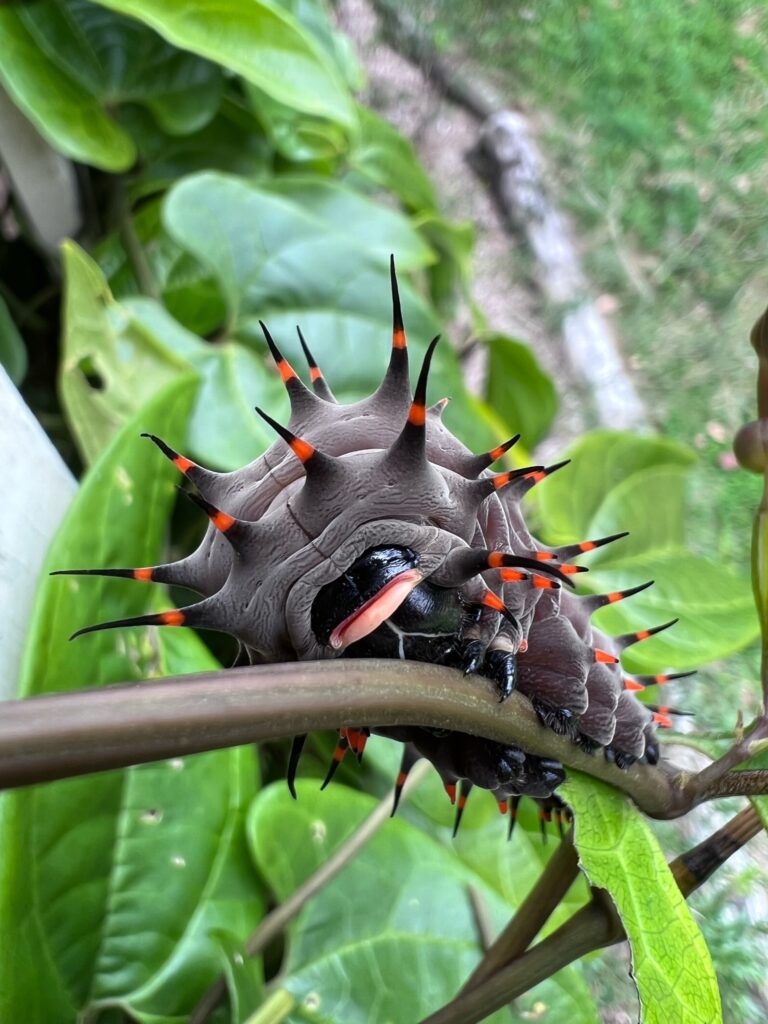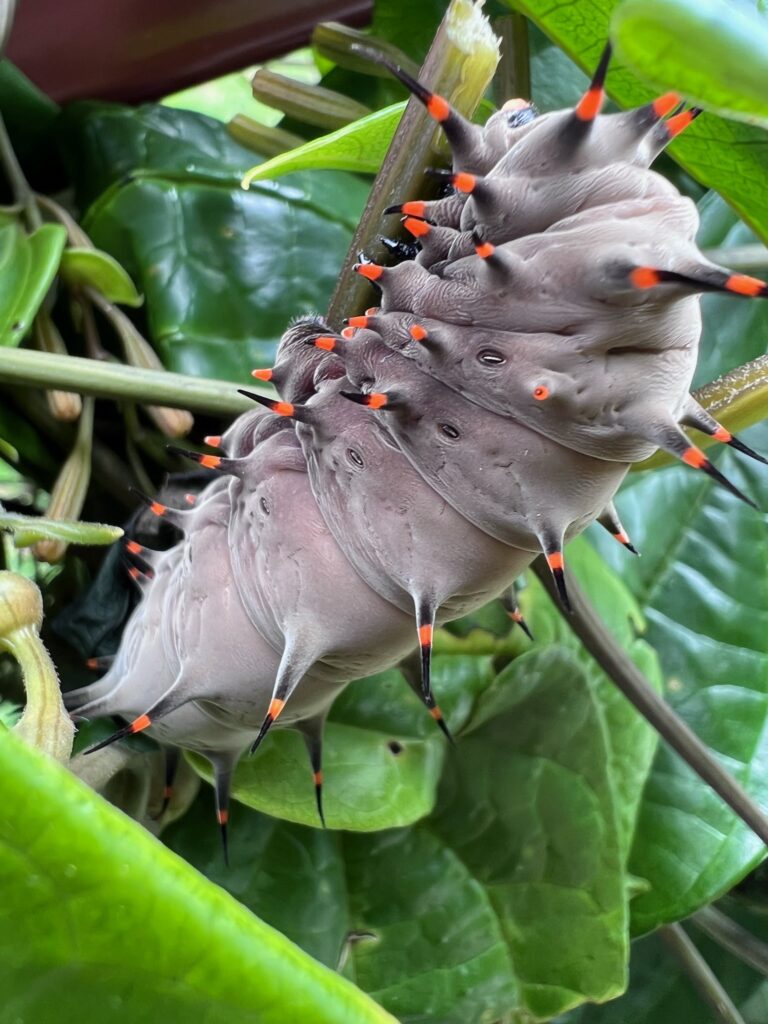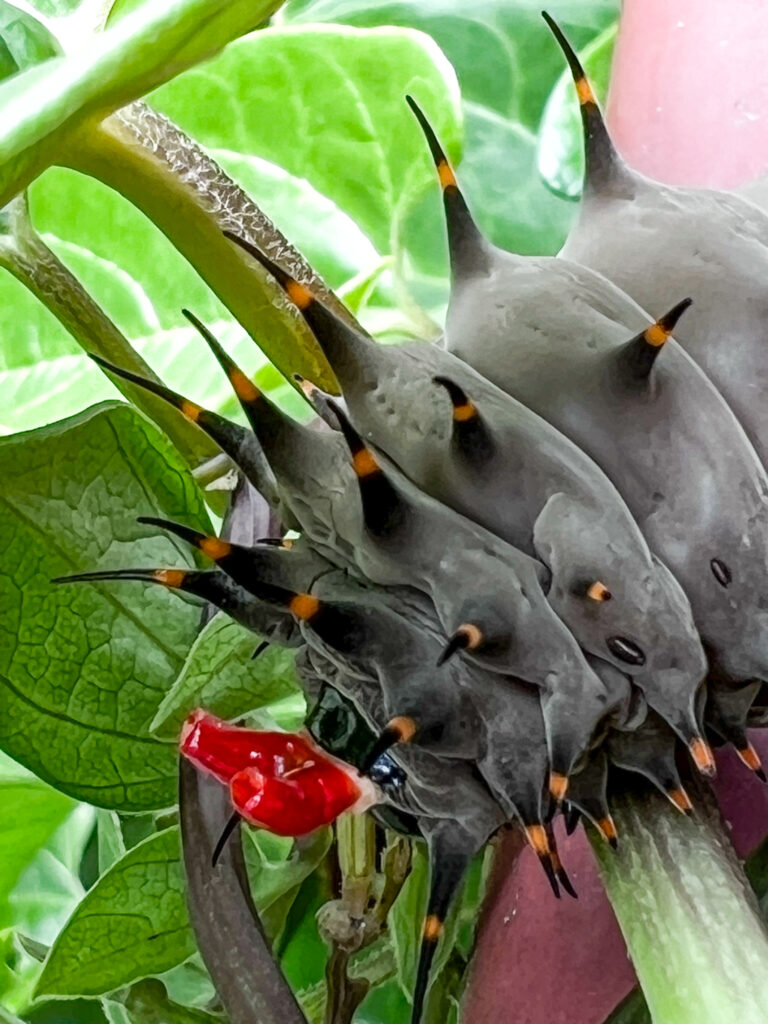Plantings of the native vine Aristolochia tagala (aka Aristolochia acuminata) have now wrapped a sizable section of the railings at the Paluma Village Hall deck in a thick mass of large green leaves.
Somewhat hidden amongst the foliage and emerging flowers and fruit, the larvae of the Cairns Birdwing butterfly (Ornithoptera euphorion) are happily munching their way towards the time they will leave the dense vines behind and move to a more open position before transforming into their chrysalis form. By the time the caterpillars are ready to pupate they have grown to about the size of a human adult’s thumb.



They need to move out of the dense foliage so they have plenty of space to unfold their damp and soft wings when they emerge in their final form as Australia’s largest endemic butterfly.
The Birdwings and some other Swallowtail species rely exclusively on the native vines Aristolochia tagala (aka Aristolochia acuminata) and Pararistolochia deltantha as the food sources for their caterpillars.
Using chemical receptors on her forelegs the female Birdwing butterfly is able to tell by “tasting” various leaves with chemical receptors on her forelegs that she has found an Aristolochia vine. At the end of her abdomen are other sense organs that help her then locate tender young leaves suitable as caterpillar food.
Aristolochia vines are poisonous, but the caterpillars of Birdwings (and other Swallowtail species) are able to use the plant poison in our native species for their own protection and so store the toxins in prominent fleshy orange-red spines on their backs.
When threatened by hungry birds (or curious humans at the village hall) the Birdwings and other members of the Swallowtail butterfly family turn toxins to their defence using an inbuilt defence mechanism anatomically referred to as the Osmeterium
The Osmeterium is an organ above the head of the caterpillar in the first body segment. If the caterpillar feels threatened, two bright red or orange horns pop out, as well as a very smelly, bitter fluid utilising the stored Aristolochia toxin.
All our Swallowtail butterfly caterpillars — the big butterflies like Cairns Birdwings, Orchards and Ulysses — have this defence mechanism.
Because of the shape of the flowers, the common name for various species of Aristolochia and Pararistolochiais Dutchman’s Pipe.
But while the Swallowtails thrive on the Australian species of these vines, a foreign species (Aristolochia elegans) is deadly for them.
The deadly form of Dutchman’s pipe imported from South America for ornamental plantings sends out the same chemical signals to the female swallowtails as our native species. They are fooled into laying their eggs on it. But the emerging caterpillars cannot cope with the stronger toxins of Aristolochia elegans and are eventually poisoned and killed.
Aristolochia elegans plants are spreading from gardens into the natural environment and are endangering the future of the beautiful Birdwings and the other Swallowtails.
Do plant native Aristolochia and help the swallowtails fill the summer skies with colour and movement …but check labels carefully to make sure you don’t accidentally purchase and plant the deadly foreign invaders.
Photos by Jan Cooke and text largely plagiarised from Google sources by Peter Cooke.

Are we allowed to steal a clipping? I had this vine at home and had Birdwings for only one season as they decimated it… Would love to try again in the rainforest (Hussey Rd) where I’d hope it would be more successful!
Would love to try again in the rainforest (Hussey Rd) where I’d hope it would be more successful!
Thank you Peter & Jan, this is great news, I new there was a caterpillar there somewhere, seen where it had been, but couldn’t find it.
Jill